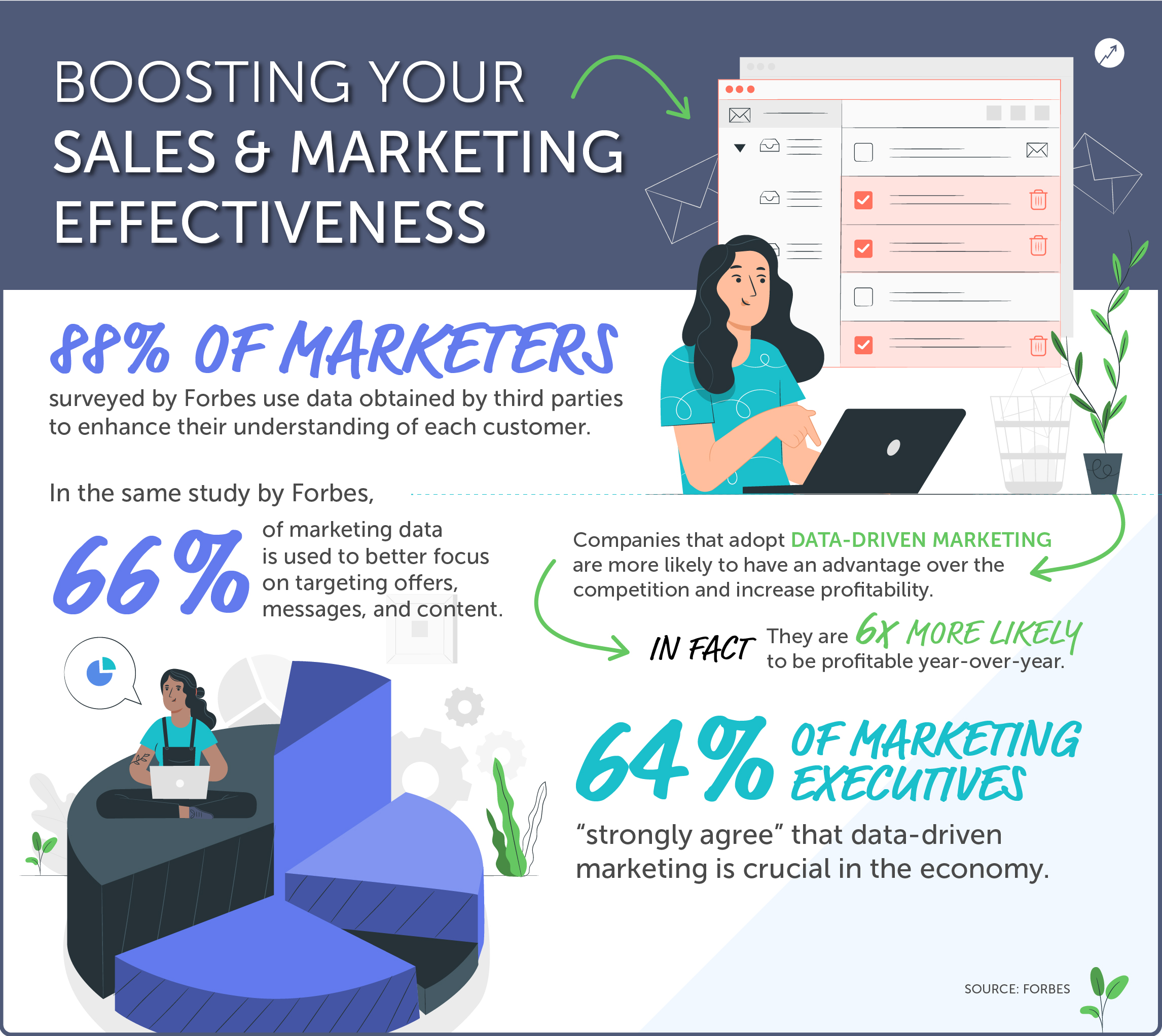Behind the effectiveness of every marketing and sales strategy is a strong B2B communication database. It doesn’t matter whether you have a small or big organization, it’s important to have the right knowledge as your foundation. Accurate contact data is what helps to build leads and boost revenue. An organized and accurate B2B communication database will improve marketing and sales campaigns to ensure that they have the right prospects.
How B2B Data Boosts the Sales Cycle and Improves the Customer Experience
Do you use cold outreach or Account-Based Marketing (ABM) to boost your sales?
Either way, B2B data helps you build a segmented list of contacts that your sales staff can use to immediately expand your lead pipeline.
The more you understand your client, the more you can market them, develop goods and services that suit their needs, obtain strategic insight, proactively detect trends in buying intent and behavior, and improve your chances of success.
Well-crafted and actionable prospects/ leads/ customer insights will act as a base for the voice of the consumer (VOC) activities within the company. And today, it has been proven to be a path to the success of top businesses.
Customer trends, requirements, and, most of all, tailored communication matters. That’s why companies need to be cautious with the B2B data in their CRMs. Redundant, obsolete, and irrelevant B2B data will lead to a loss of time, effort, and resources. To enhance the CRM experience and boost sales, the first step should be to use reliable and right B2B data.
What Type of Data is the Right Data for Your Business?
Choosing the right B2B data will directly affect the effectiveness of your marketing and sales strategy. The following are the B2B data types that you must have in your database to ensure a more focused approach in your marketing campaigns as well as targeted sales messaging to your prospects and leads.
Firmographic Data
Firmographic data contains important company details that help you categorize accounts (companies) that are suitable for you. As demographics are for individuals, firmographics have the same value for companies in their publicity and sales activities.
In short, firmographics provide specific statistics on firms such as sector, size of the staff, revenue, etc. With the aid of firmographic info, you can quickly recognize revenue factors and purchasing periods on your target accounts because you understand the business and the market.
For example, if you’re approaching companies that have just raised an investment round, you know they’re looking for tools to improve their sales and marketing activities or product growth. Since your product is focused on helping startups scale, you can use firmographic data to find startups to target.
Firmographic data includes the following:
- Company size
- Industry
- Employee size
- Office location(s)
- SIC Code
- Zip Code
- Growth trajectory
Segmenting a market and defining firmographic attributes have the following benefits:
- Business insights – Gain company insights into B2B target markets by addressing frequently asked questions such as the number of employees, where are the businesses based geographically in this target market, and the value of a business.
- Categorization of marketing strategies – Firms may be classified by the type of industry in the target markets. For example, government institutions and educational organizations have different defining characteristics. Thus, they are approached and marketed accordingly.
- Optimizing marketing strategies – Sending the right message to the right people at the right time.
- Understanding trends in data – Evaluating analytics and reports from segmented audiences makes it easier to understand data patterns. These patterns continue to improve the efficiency of promotions and revenue.
Technographic Data
Technological data contains technologies that are used by the target accounts/companies, such as:
- SAP
- Salesforce
- Marketo
- Technology History
- Google Analytics
- Recently added technologies and so on
Often, strategic data also contains technologies that the customers are trying to purchase. Also with technographic data, you can better understand the technologies that best complement your product or service. For example, if your product suits Salesforce customers well, you will target high-value clients that use Salesforce and maximize the chances of closing a good deal.
Here are some benefits of utilizing technographics in your outbound sales and marketing activities:
- More informed sales conversations – Providing useful information and understanding of the technology that an organization uses. Sales representatives can use this information to customize conversations and sales pitches.
- More targeted prospecting – You must completely understand the customers to effectively target interested prospects. Technographics can strengthen buyer persona by evaluating the technological stack of the prospects.
- Improve close rates – More targeted prospecting plus informed sales conversations are equivalent to stronger leads and higher closing rates.
Combine the technographic data with the firmographic data to ensure that you target the best accounts at the right time. SalesIntel helps you to make sure that the data is easily accessible, updated, and accurate.
Account Data
Identifying accounts based on your optimal customer profile is the first step in launching outbound campaigns (or even certain elements of inbound campaigns). Account data contains the businesses or ‘accounts’ you want to reach, including high-value accounts, the next best ideal customers, etc. Most notably, account data contains any information about an account that will help you identify the businesses on the list and see if they are ready for your product/service.
It is also important to remember that the account data also overlaps with other forms of data such as Firmographics, Technographics, etc.
Basic examples of account data include:
- Company name
- Employee size
- Website Traffic
- Recent funding
- Recent hiring
- Company’s social media accounts
- Paid ads, keywords
- Recently published content etc.
Common sources of account data include the usual suspects – LinkedIn, business forums, business directories, and data intelligence tools.
Intent Data
Intent data analyze the intent of the people in your target accounts. Simply put, goal data helps show where the prospect is on the purchaser’s trajectory and whether it is a good lead-to-account match. Both firmographic and technographic data will help you sort accounts while the intent data will provide you with the actions of the individuals behind these accounts.
Intent details include the following:
- Topics or keywords that your target accounts/contacts are actually looking for
- Clicks on ads
- Participation in social media, etc.
Intent data providers including, SalesIntel, Bombora, etc. will offer useful visibility into your target accounts or current B2B database – without the burden of having to search through various sites and social media.
Engagement Data
Think of engagement data as measuring how your prospects think, where they’re on their path to buying, and how they’re reacting to various forms of contact from you. It is a step above intent data as it tracks how your target accounts are involved in your promotion and sales activities right now.
Commitment data includes:
- Previous sales
- Account activity levels
- Content engagement
The most famous source of this data is right under your nose, your CRM. Other possible outlets include LinkedIn to monitor account and sales rep operations, executive content engagement, web analytics, and more.
Although this type of data can be the most difficult to read and interpret, SalesIntel will help you determine and estimate whether an account of yours is suitable to buy your product.
Contact Data
These are the key items– think of the contact details as the enabler or the real information that helps you contact the people behind the accounts on the list. The contact details contain the following details:
- Contact name
- Job title
- Email address
- LinkedIn account
- Other social media accounts
- Direct-dial numbers
With the aid of contact info, you can create tailor-made strategies to target individuals behind the accounts.
Popular contact data sources include LinkedIn, social media sites, forums, etc. However, this information is usually gathered and distributed better by third-party platforms such as LinkedIn Sales Navigator or SalesIntel which are designed for mining this kind of data.
There are both good and bad database providers in the data industry. It is important to contact a reliable B2B data partner by ensuring that they can hand-tailor organized and relevant data to your needs.
Access The Must-Have Data at One Place with SalesIntel
Accessing the different data from multiple platforms can be frustrating and creates human errors. To make this process simple, easy, and clean, SalesIntel provides all the ‘must-have’ data in one place. With SalesIntel, you can filter your data based on firmographics, technographics, and Buyer Intent Data. Additionally, you get access to VisitorIntel where you can unmask the identity of people visiting your website.






